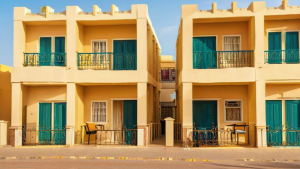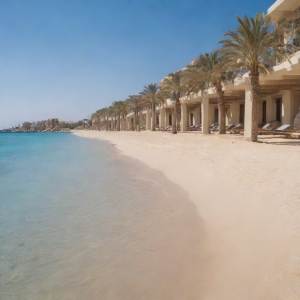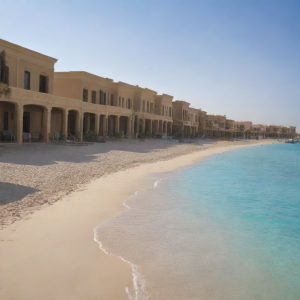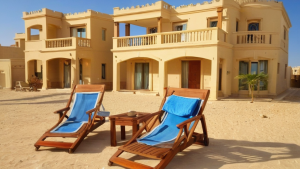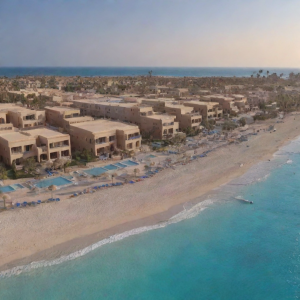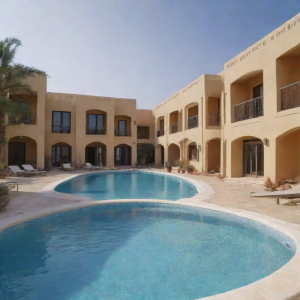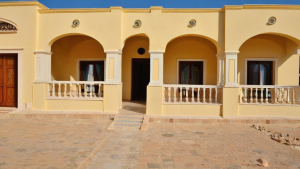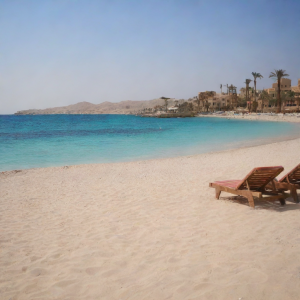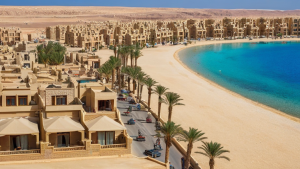Summary about owning and buying property in Hurghada, Egypt.
- Understanding the monthly weather patterns in Hurghada can help you prepare for your visit, ensuring a comfortable experience in this popular tourist destination.
- May is the ramp-up to the hot summer months, with temperatures climbing to between 25°C and 33°C (77°F to 91°F).
- This is a popular time for tourists, but staying hydrated and seeking shade during the hottest parts of the day is crucial.
- As summer draws to a close, September sees temperatures starting to moderate a bit, ranging between 26°C and 34°C (79°F to 93°F).
- This is a great time to explore the local culture and scenic sights without the overwhelming heat.
Monthly weather patterns in Hurghada, Egypt: an overview
Hurghada, Egypt, is a stunning coastal city along the Red Sea, known for its beautiful beaches, vibrant marine life, and year-round sunshine. Understanding the monthly weather patterns in Hurghada can help you prepare for your visit, ensuring a comfortable experience in this popular tourist destination. With its desert climate, the weather here brings warm temperatures and minimal rainfall, making it essential for travelers to plan accordingly.
January
January is one of the cooler months in Hurghada. Daytime temperatures usually range from 18°C to 21°C (64°F to 70°F), while nights can drop to around 10°C (50°F). This month sees slightly more humidity, but rain is rare. If you’re visiting, light layers for the evenings are recommended. Perfect for outdoor activities, this period attracts many tourists, especially those who want to enjoy pleasant conditions.
February
February remains cool, with temperatures hovering between 17°C and 23°C (63°F to 73°F). Although still mild, this month typically brings occasional windy days. Plan for slightly warmer clothing in the evenings. It’s an ideal time for sightseeing without the intense heat of summer, allowing you to explore historical sites and enjoy beach activities.
March
March marks the beginning of warmer weather in Hurghada. Temperatures can reach between 20°C and 26°C (68°F to 79°F) during the day, which makes this month fantastic for snorkeling and scuba diving. Humidity begins to rise, so consider packing your beachwear if you’re planning to relax by the water. Nighttime temperatures still remain comfortable, around 12°C (54°F).
April
April temperatures can soar from 22°C to 30°C (72°F to 86°F). With fewer chances of rain, it’s the perfect time for sunbathers and outdoor enthusiasts. You might need sunscreen and a wide-brimmed hat to protect yourself during the day. Evenings will still be mild, but it’s advisable to keep hydrated as temperatures rise.
May
May is the ramp-up to the hot summer months, with temperatures climbing to between 25°C and 33°C (77°F to 91°F). It’s important to prepare for higher humidity. Swimming and water sports are in full swing, so enjoy the warm sea temperatures. Don’t forget your sunglasses and sunblock to make the most of your time on the beach.
June
June brings peak summer heat to Hurghada, with temperatures often ranging from 28°C to 36°C (82°F to 97°F). The weather becomes increasingly hot and dry, so be mindful of sun exposure. This is a popular time for tourists, but staying hydrated and seeking shade during the hottest parts of the day is crucial. Evening strolls along the beach become more pleasurable as temperatures cool down slightly.
July
July continues the trend of hot temperatures, often exceeding 38°C (100°F) during the day. If you visit this month, try to plan your outdoor excursions early or late in the day. July offers clear skies and calm seas, ideal for diving and snorkeling. Just remember to take extra precautions against dehydration.
August
August remains extremely hot, with similar temperature ranges as July. Daytime heat can feel oppressive; thus, it’s crucial to schedule rest periods. The sea temperatures also peak, making swimming incredibly inviting. Evenings might still be warm, so lightweight clothing will ensure comfort during your stay.
September
As summer draws to a close, September sees temperatures starting to moderate a bit, ranging between 26°C and 34°C (79°F to 93°F). Although hot, this month often has more manageable evenings. It’s typically less crowded than the peak summer months, allowing for more serene beach experiences.
October
October is an excellent month to visit, with temperatures averaging between 24°C and 30°C (75°F to 86°F). The humidity levels start to drop, and the weather remains pleasant. This is often considered a prime time for beach lovers and adventure seekers alike.
November
November cools further, with daytime temperatures between 21°C and 27°C (70°F to 80°F). The evenings can be chilly, so layers are still necessary. This is a great time to explore the local culture and scenic sights without the overwhelming heat.
December
December is similar to January, with daytime temperatures ranging from 19°C to 24°C (66°F to 75°F). Nights can be cooler, so bring along some warmer clothing. It remains an ideal time for enjoying the beach and outdoor activities with fewer crowds around.
Understanding the monthly weather patterns in Hurghada helps you prepare for your visit effectively. Regardless of when you choose to travel, know that packable essentials like sunscreen, light clothing, and hydration will enhance your experience in this lively Red Sea resort destination.
Essential packing tips for each season in Hurghada
Traveling to Hurghada, Egypt, offers a chance to bask in beautiful weather and stunning landscapes throughout the year. However, understanding seasonal changes is crucial for packing smartly and ensuring a comfortable trip. Here’s a breakdown of what to pack for each season in Hurghada, so you can enjoy your vacation without any worries.
Winter (december to february)
Winter in Hurghada is mild and pleasant, making it a popular time for tourists. Daytime temperatures range from 20-25°C (68-77°F), while evenings can get cooler, dropping to 10-15°C (50-59°F). To prepare, consider the following essentials:
- Light layers: Pack long-sleeve shirts and light sweaters for the evenings. A light jacket is also advisable, especially for night outings.
- Comfortable shoes: Bring walking shoes for exploring the local area and beach shoes for time spent by the shore.
- Swimwear: Despite cooler evenings, daytime remains warm enough for swimming, so don’t forget your swimsuit.
- Sun protection: Sunscreen, a hat, and sunglasses are essential as the sun can still be intense during the day.
Spring (march to may)
Spring welcomes warmer temperatures, with averages between 25-30°C (77-86°F). As the season progresses, it can stretch into the hotter months. Packing wisely will ensure comfort during your stay:
- Light clothing: Opt for breathable fabrics like cotton and linen. T-shirts, shorts, and sundresses are great choices for daily wear.
- Swimwear: Water activities remain popular, so pack additional swimsuits, and consider bringing a cover-up for the beach.
- Hat and sunglasses: These will shield you from the sun as temperatures rise.
- Hydration gear: A reusable water bottle is and should be handy for staying hydrated throughout the day.
Summer (june to august)
Summer in Hurghada can be extremely hot, with temperatures frequently reaching above 38°C (100°F). Here’s how to pack for a comfortable visit during this sweltering season:
- Cool clothing: Lightweight and loose-fitting clothes are a must. Think tank tops, shorts, and breathable dresses.
- Sunscreen: A high-SPF sunscreen is crucial to protect your skin from harsh UV rays.
- Swim essentials: Multiple swimsuits are a good idea as you’re likely to spend most of your time in the water.
- Chill accessories: Bring a beach umbrella or a hat with a wide brim to provide the shade you’ll need.
- Evening attire: Lightweight maxi dresses or linen trousers are great for dinner outings as evenings can be warmer.
Autumn (september to november)
As the heat starts to dissipate, autumn offers warm days and milder evenings, making it ideal for travelers. Expect averages between 25-30°C (77-86°F). For this season, consider:
- Layered clothing: Mornings and evenings can be cooler, so pack light sweaters or wraps to stay comfortable.
- Flip-flops and sandals: These are convenient for both beach time and casual outings.
- Waterproof items: While rain is rare, it’s wise to pack a light, waterproof jacket just in case.
- Comfortable walking shoes: Great for exploring cultural sites in and around Hurghada.
No matter what season you visit, being prepared will enhance your experience in Hurghada. By understanding the weather patterns and packing accordingly, you ensure that your trip is enjoyable and stress-free. Don’t let unexpected temperatures catch you off guard – pack smart and make the most of your Egyptian adventure!
Activities to enjoy in Hurghada based on monthly weather
If you’re planning a visit to Hurghada, Egypt, understanding the monthly weather patterns can greatly enhance your experience. Each month brings its unique climate, perfect for different activities that showcase the beauty of this stunning coastal city. Here’s how you can make the most out of each month in Hurghada, tailored to the varying weather.
January – February
These months mark the winter season in Hurghada, with mild temperatures ranging from 15°C to 25°C (59°F to 77°F). This is an ideal time for outdoor activities without the scorching heat.
- Snorkeling and Diving: The underwater visibility is superb during winter months.
- Desert Safaris: Experience the beauty of the desert without overheating.
- Historical Tours: Visit the ancient sites around Luxor and the Valley of the Kings.
March – April
As spring approaches, temperatures begin to rise slightly, ranging from 20°C to 28°C (68°F to 82°F). The pleasant weather still supports many outdoor adventures.
- Water Sports: Ideal for kite surfing and windsurfing, thanks to mild yet breezy conditions.
- Beach Days: Sunbathe or relax on the stunning sandy beaches.
- Cultural Festivals: Enjoy local festivities to celebrate the arrival of spring.
May – June
Summer begins to set in with temperatures ranging from 24°C to 34°C (75°F to 93°F). This period can be quite hot, particularly in June. However, there are still plenty of activities to enjoy if you plan wisely.
- Early Morning Activities: Opt for early morning snorkeling or diving trips.
- Evening Strolls: Visit the marina for a beautiful sunset and less crowded atmosphere.
- Boat Trips: Spend time on a glass-bottomed boat to enjoy underwater views without getting wet.
July – August
These are the hottest months in Hurghada, with temperatures often exceeding 35°C (95°F). Therefore, it’s crucial to stay hydrated and plan your activities for cooler parts of the day.
- Pool Days: Relax at resort pools or enjoy poolside services.
- Nighttime Excursions: Take advantage of cooler evenings for dining and nightlife.
- Indoor Attractions: Explore local museums or markets during the hottest hours.
September – October
The heat gradually subsides and temperatures range from 25°C to 34°C (77°F to 93°F). This transitional period brings splendid weather, perfect for exploring outdoor and aquatic activities.
- Autumn Festivals: Engage in local cultural activities and celebrations.
- Diving and Snorkeling: Continue to enjoy clear waters and vibrant marine life.
- Island Hopping: Take a trip to nearby islands like Giftun for more private beach experiences.
November – December
As December approaches, temperatures start cooling down again, averaging between 15°C to 25°C (59°F to 77°F). This is another fantastic time for visiting Hurghada, especially for those wanting to escape colder climates.
- Cultural Tours: Explore local art galleries and traditional markets.
- Relaxation: Unwind with spa days at luxurious resorts.
- Holiday Celebrations: Experience unique local events leading up to the New Year.
By tailoring your activities to the monthly weather patterns in Hurghada, you can ensure that your visit is enjoyable and memorable. Knowing what to expect allows you to plan effectively, maximizing your time in this beautiful Egyptian city.
Understanding local climate changes and their impact
Climate change is a pressing issue that affects every corner of our planet, bringing with it a range of local impacts. Understanding these changes is crucial for communities, businesses, and policymakers. The local climate doesn’t just influence weather patterns; it also affects agriculture, water resources, health, and even job markets. Here’s an examination of how local climate changes unfold and the effects they bring.
Temperature fluctuations
One of the most noticeable local climate changes is the rise in temperature. As global temperatures increase, many regions are seeing hotter summers and milder winters.
- Increased energy demands for cooling during hot months.
- Higher risks of heat-related illnesses, especially among vulnerable populations.
- Changes in local ecosystems, which affects wildlife and plant diversity.
Altered precipitation patterns
Along with rising temperatures, changes in precipitation patterns are becoming more common. Areas that used to receive consistent rainfall may experience droughts, while others may face periods of excessive rain.
- Droughts can lead to water shortages, affecting agriculture and drinking supplies.
- Heavy rainfall can increase the risk of flooding, prompting concerns for infrastructure and safety.
- Changes in precipitation can disrupt seasonal crops, challenging farmers to adapt.
Impact on agriculture
Agricultural practices are particularly sensitive to local climate changes. Farmers rely on consistent weather patterns for planting and harvesting crops. When the climate shifts unexpectedly, it can pose serious challenges.
- Crop yields can fluctuate dramatically from year to year.
- Farmers may need to invest in new crop varieties that are more resilient to changing conditions.
- Increased pests and diseases may thrive in warmer climates, damaging crops.
Water resource management
Climate change influences local water resources significantly. As temperatures rise and rainfall patterns shift, the availability of water can become uncertain.
- Groundwater supplies may dwindle if not replenished by adequate rainfall.
- Competing demands for water from agricultural, industrial, and domestic users can create tension.
- Communities must consider sustainable water management practices to prepare for future uncertainties.
Health risks and challenges
Human health is intricately linked with climate conditions. As the climate changes, so do the risks for various health issues.
- Increased heat can lead to heat strokes and exacerbate chronic illnesses.
- Shifting climatic conditions can facilitate the spread of vector-borne diseases such as malaria and dengue fever.
- Poor air quality arising from higher temperatures can lead to respiratory problems.
Economic implications
The local economy is also significantly impacted by climate changes. Both direct and indirect effects can alter economic landscapes.
- Industries like agriculture, fishing, and tourism may undergo transformation, requiring adaptation to new realities.
- Costs related to disaster relief and infrastructure rebuilding can put a strain on local budgets.
- Businesses may face increased insurance premiums as risk assessments change due to climate events.
Community and social dynamics
Climate change can exacerbate social inequalities within communities. Vulnerable populations may be disproportionately affected by climate impacts, which can lead to greater social strife.
- Displacement due to extreme weather events can force communities to move, leading to loss of social networks.
- Job losses in climate-sensitive industries can deepen economic divides.
- Community resilience initiatives will be crucial in preparing everyone for changing conditions.
Local climate changes present challenges that influence various aspects of life. From agriculture and health to the economy and social dynamics, the impacts are broad and deep. By understanding these changes, communities can better prepare and adapt, ensuring that they can thrive amidst evolving environmental conditions.
Preparing for extreme weather events: a local guide
Extreme weather events can happen anywhere, including in regions where you might least expect them. Knowing how to prepare for these events is crucial for your safety and peace of mind. Being proactive will not only protect your family and property but also make the recovery process smoother should something unexpected occur. Here’s a guide on how to be ready for extreme weather.
Understanding the types of extreme weather
Extreme weather can take various forms, each requiring a different approach in terms of preparation. Here are some common types of extreme weather you might face:
- Heavy Rain and Flooding: This can lead to flash floods, especially in urban areas.
- Heatwaves: Extreme heat can be dangerous, especially for vulnerable individuals.
- Severe Storms: Thunderstorms, tornadoes, and hurricanes can cause significant destruction.
- Winter Storms: Ice and snow can disrupt transportation and utilities.
- Wildfires: These are more common in dry seasons and can spread rapidly.
Creating an emergency plan
The first step in preparing for any extreme weather event is creating a comprehensive emergency plan. Here’s how to go about it:
- Identify Risks: Determine what types of extreme weather events are most likely in your area.
- Designate a Meeting Place: Choose a safe location where family members can gather if separated.
- Plan Communication: Establish a plan for staying in touch. Make sure everyone knows how to reach each other.
- Review and Practice: Go over the plan regularly. Conduct practice drills to ensure everyone remembers what to do.
Preparing an emergency kit
Having an emergency kit is vital when preparing for extreme weather. Here’s what you should include:
- Water: At least one gallon per person per day for at least three days.
- Non-perishable Food: Enough for at least three days. Think canned goods, energy bars, and dried fruit.
- Flashlight: With extra batteries to provide light if the power goes out.
- First Aid Kit: Make sure it contains all the essentials like bandages, antiseptic wipes, and any prescription medications.
- Multi-tool: A useful item that can serve multiple purposes during emergencies.
- Sanitation Supplies: Items like moist towelettes and garbage bags for personal sanitation.
Home safety precautions
Making your home more resilient to extreme weather is an essential preparation strategy:
- Secure Windows and Doors: Use storm shutters or boarding up windows to prevent breakage during storms.
- Maintain Gutters: Clear them regularly to avoid water overflow and flooding.
- Trim Trees and Bushes: Remove dead branches that could fall during storms and cause damage.
- Install Sump Pumps: Protect your basement from flooding by installing sump pumps and ensuring proper drainage.
Stay informed
Being aware of weather forecasts can provide you with a significant advantage. Use these tips to stay updated:
- Weather Apps: Download reliable weather apps on your phone for real-time updates.
- NOAA Alerts: Sign up for alerts from the National Oceanic and Atmospheric Administration for timely notifications.
- Local News Channels: Watch for announcements related to extreme weather in your area.
Understanding community resources
Your community likely has resources available during extreme weather events. Familiarize yourself with local evacuation routes, emergency shelters, and community groups that assist during disasters. Here’s how to connect:
- Join Local Preparedness Groups: These organizations often organize workshops and provide additional resources.
- Contact Local Government: They can provide critical information on community resources and safety measures.
Arming yourself with knowledge and preparation is your best defense against extreme weather events. By following these tips, you can rest assured knowing that you are ready for whatever nature may throw your way. Safety is not just an option; it’s a necessity.
Understanding the monthly weather patterns in Hurghada, Egypt, equips you with the right tools to make the most of your visit. By tailoring your packing list to the unique seasonal needs,from lightweight clothing for warm summer days to warmer layers during mild winter nights,you ensure comfort throughout your stay. Each season offers its own set of activities, from snorkeling in crystal-clear waters during summer to exploring cultural sites during the cooler months.
Additionally, being aware of local climate changes can help you adapt your plans accordingly. This knowledge is essential, especially as extreme weather events can occur occasionally. Preparing for these eventualities not only keeps you safe but also allows you to enjoy your trip without stress.
Utilizing this guide enhances your experience in Hurghada, ensuring that you not only appreciate its beauty but also respect its climate. Whether you’re lounging by the beach in July or exploring the vibrant local markets in February, you’re now equipped to embrace everything this stunning destination has to offer. By understanding and preparing for the environmental factors at play, you can maximize your enjoyment and create unforgettable memories during your stay in Hurghada. With the right preparation and an adventurous spirit, you’re set for a remarkable journey.


